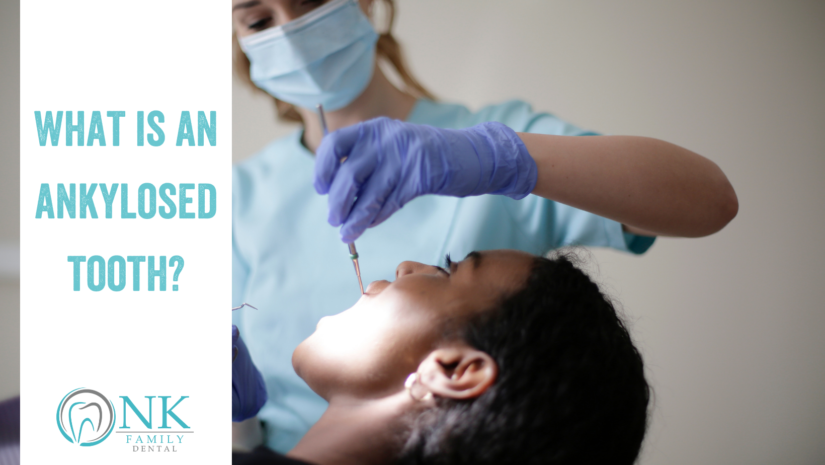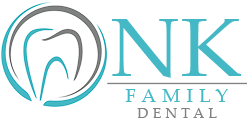
Primary (baby) teeth are important to a child’s oral and overall health. They are instrumental in establishing favorable conditions for the permanent teeth to emerge and position themselves correctly — which is why we at NK Family Dental recommend that children receive their first dental visit shortly after their initial teeth begin emerging. This provides us with an early look at your child’s teeth and gums, allowing us to make sure that everything is developing properly.
While most regular examinations reveal that all is well, or indicate the need for preventive treatment, a rare condition may be discovered — such as an ankylosed tooth.
In normal tooth anatomy, the root is attached to the bone by collagen fibers that make up the periodontal membrane — also called the periodontal ligament. In contrast, an ankylosed tooth has fused directly to the bone, which means that the periodontal ligament no longer separates the tooth from the surrounding portion of the jawbone. For this reason, an ankylosed primary tooth cannot loosen and fall out to be replaced by a permanent tooth. The ankylosed tooth eventually begins to sink and becomes submerged by the gum tissue.
A permanent tooth can also become ankylosed. As an article by Colgate points out, ankylosis affects primary teeth 10 times more often than adult teeth. The one-year-old molar in the lower jaw is the tooth that ankylosis most commonly affects, and a person may have only a single ankylosed tooth or several. Lower teeth are more than twice as likely to be ankylosed. According to the International Organization of Scientific Research’s Journal of Dental and Medical Sciences (IOSR-JDMS), the prevalence of ankylosis ranges from 1.3 to 14.3 percent of people, has a higher incidence in siblings and is slightly more common in females.
What Causes an Ankylosed Tooth?
A genetic predisposition can be a factor, as well as trauma — such as a jaw injury, inflammation, or infection. Occasionally, dental ankylosis may be associated with the fifth finger clinodactyly. This is a congenital condition in which one or more fingers curve to one side — although it is usually the little (pinky) finger that’s affected.
However, the causes of tooth ankylosis remain mostly unknown. Although it is a form of resorption, tooth ankylosis is different from external root resorption, the details of which are covered in our blog post — “What is Root Resorption?”
What Happens if an Ankylosed Tooth Goes Undetected and Untreated?
In children, this condition could cause other oral health issues, such as difficulty chewing if the back teeth do not touch each other. It also may cause the loss of neighboring teeth to cavities and periodontal disease. The permanent tooth that should have emerged instead becomes impacted.
An article for Jungle Roots Children’s Dentistry & Orthodontics describes the consequences as follows:
“The most common issue is malocclusion (poorly aligned teeth) that can negatively impact the function of the teeth. If the tooth is noticeably lower, it could make chewing difficult. All the surrounding teeth may not erupt into the correct position, the neighboring teeth can tip in toward the ankylosed tooth and are often more prone to developing cavities and periodontal disease.
“Sometimes, the jaw may not develop normally. This can have a negative impact on the growth and development of the face and change its appearance. When the jaw is deformed and the teeth are misaligned, a person can also struggle with chewing, swallowing, and impaired speech.”
An ankylosed adult tooth can go completely unnoticed unless it needs dental restoration or will not move with braces during orthodontic treatment. When ankylosis affects a permanent tooth in an adult, growth has already stopped — which means it won’t cause malformation of the jaw or other facial structures. However, the root of the ankylosed tooth will typically undergo continual resorption and subsequent replacement with bone. Because an ankylosed permanent tooth involves numerous variables depending upon the patient, your dentist will determine how to proceed with treatment.
Symptoms of an Ankylosed Tooth
The most obvious indication of an ankylosed tooth in a child is a tooth that is over-retained — that is, a primary tooth that does not fall out when it’s supposed to be shed. The American Dental Association (ADA) provides this helpful chart of primary and permanent teeth, listing the ages at which baby teeth should emerge and start shedding, as well as the ages during which permanent teeth should emerge.
As discussed earlier, the following are also symptoms. But by the time they become observable, the damage is already well underway.
- A reduced number of teeth
- Abnormal tooth enamel
- Abnormal dentition
- An enlarged lower jaw
In adults, an ankylosed permanent tooth is often asymptomatic — although, also as previously mentioned — this does not mean it won’t become a problem eventually.
For children, regular dental examinations and X-rays are the only means of early detection. Your pediatric dentist will be able to identify the problem tooth through a visual examination, and the results are typically confirmed with a dental X-ray.
As adults with this condition are likely to be unaware of anything abnormal, an X-ray is necessary to detect tooth ankylosis. For those who schedule regular examinations, tooth ankylosis can be detected early, increasing the possibility of treatment with a good overall outcome.
Because jaw injury and infection are possible causes, let your child’s dentist — or your dentist — know, should either be a factor.
Treatment of Dental Ankylosis
Once detected, treatment usually consists of removing the ankylosed tooth so that the adult tooth will grow properly. A space maintainer might also be placed to hold the space until the adult tooth erupts. Other options may include placing a restorative material to raise the height of the tooth. An ankylosed tooth that is negatively influencing the development of the jaw or other teeth will often require orthodontic treatment.
For adults, the treatment decision on whether to keep the ankylosed tooth — and possibly restore it — or remove it, will depend on the esthetic impact of any hard/soft tissue defect and the rate at which the resorption is occurring. Your dentist will be able to advise you on the treatment course best for your individual situation.
The Take-Home Message
Tooth ankylosis is a rare condition that can affect primary or permanent teeth. Although not common, it can cause the loss of neighboring teeth to cavities and periodontal disease, maldevelopment of the jaw and/or lower face, and other serious problems when it occurs in children. Adults may not experience symptoms, but the process will continue, necessitating treatment at some point.
Early detection through regular dental exams is essential to getting the right treatment for your child before tooth ankylosis progresses to an advanced stage. For adults, the sooner tooth ankylosis is discovered, the more options you may have for treatment that will allow you to enjoy continued good oral health and a bright, confident smile!
We understand that the main concern you may have is cost, which is why we accept all major PPO plans for dental insurance and also offer our in-house dental plan. Please see our financing page for more information.
At NK Family Dental, it is our mission to provide the highest quality and most compassionate oral care to our Chicago patients, including both dental and periodontal services. Our dental specialists include our general dentist, Dr. Nilofer Khan, our endodontist, Dr. Sabek, and our periodontist, Dr. Amir Danesh. Dr. Danesh is a board-certified periodontist and Diplomate of the American Board of Periodontology. He has contributed to the publication of two books, as well as published over 20 papers in prestigious dental research journals.
We serve the neighborhoods of Logan Square, Bucktown, Humboldt Park, and Wicker Park with the dedication that’s earned us the reputation as the Best Dentist in Chicago!
Schedule your visit through ZocDoc, or contact us directly. We look forward to treating you soon!
